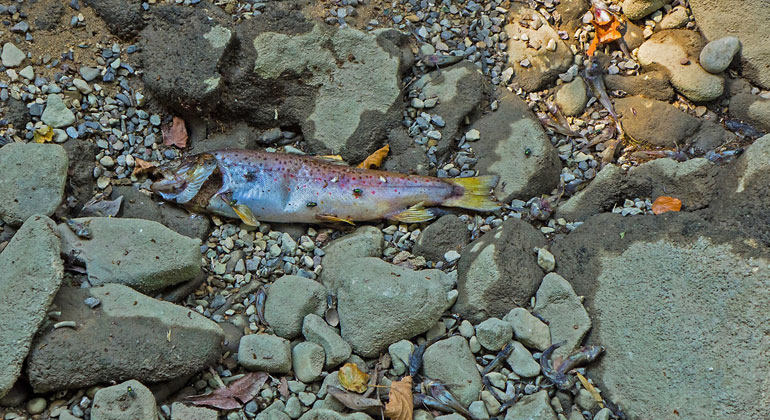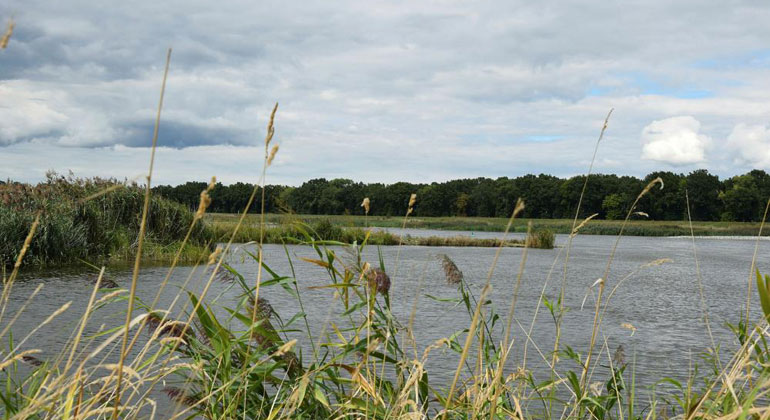Fishing in the wake of the Oder River disaster shows no sign of recovery
Very few fish and still elevated salinity levels
IGB has been fishing the Oder at least three times a year for scientific purposes for 23 years. The objective is to determine the current state of fish stocks, as well as any short-term and long-term changes. Routine fishing on 29 November this year was the first large inventory conducted in the middle of the Oder since the man-made environmental disaster that occurred in summer. The result: much fewer fish were caught in total, and species such as the blue bream and the asp, which are important to this ecosystem, were lacking completely. Moreover, water analysis conducted by the researchers shows that the salt concentration is still far too high. There could be a repeat of the disaster when temperatures increase, endangering remaining stocks.
A team led by IGB scientist Christian Wolter used a research vessel to fish a stretch of the Oder from Hohensaaten to the Marienhofer Wehr on 29 November 2022. This fishing event in the middle of the Oder was the first large inventory conducted since the environmental disaster in summer 2022 that led to the massive kill of fish, mussels and other benthic invertebrates.
It was in August that IGB first managed to detect elevated concentrations of the brackish water alga Prymnesium parvum in the river. The alga can produce strong toxins, which is what happened in the Oder. However, the disaster was not natural but man-made: it was only because of the high salinity level, the high nutrient concentrations, the low water flow and the warm temperatures that the toxic alga was able to develop massively in the Oder.
Not only fewer fish, but also severe depletion of mussels and snails

The fishing operation involved the research team dragging a large trawl along a 37 kilometre stretch of the river, 12 times in all. The vessel drags the trawl 1,000 metres each time. Science-based fishing enables comparability over decades. The results clearly show that the Oder has not “recovered” at all. The man-made environmental disaster has drastically reduced stocks of all species. This is also the case for key species such as the blue bream and the asp, which are typically found in this river ecosystem. Not a single specimen of these species was caught — and what is more, only a handful of white bream were captured.
In total, the researchers caught only half as many fish as in previous years on average. This time, there were also hardly any mussels and snails, which occasionally get caught in the net during fishing, but are not routinely recorded. “The Oder River disaster has reduced mussel biomass by half,” estimated Christian Wolter. Besides being the most important filter-feeders in the ecosystem, they are also a food source for fish. “It will take a very long time for stocks to replenish, because mussels are not mobile enough to leave their refuge and repopulate areas quickly,” the ecologist noted.
He therefore strongly urged: “It is now vital that we do everything we can to protect the Oder ecosystem to ensure maximum survival rates. This also means restoring habitats and significantly reducing substance inputs.”
Salinity levels still far too high, no decrease in discharges
In fact, measurements of conductivity during fishing showed that salinity levels are still far too high. At the Frankfurt (Oder) gauge, conductivity has been more than 1,900 micro-Siemens per centimetre (microS/cm) since mid-November; at the time of sampling on 30 November, the figure was above 2,000 microS/cm, exceeding the measuring range limit. In the Lower Oder, conductivity was more than 1,400 microS/cm. This value is still high, even though the water is already diluted by the inflow of the Warthe in those reaches.
The water samples were investigated by Tobias Goldhammer and his team at IGB’s Chemical Laboratory. “Our chemical analyses show a very similar ion profile to that in summer. The major component of the salt load continues to be sodium chloride, i.e. common salt. We detected around 400 milligrammes of sodium chloride per litre of water in water samples from the Lower Oder, which equates to about half of the total amount of salt in these samples. We also know from the monitoring points that much more salt must have dissolved in the river water upstream. This leads us to conclude that discharges continue unabated,” the biogeochemist declared.
Setting concentrations instead of loads
What is more, the flow is currently 130 cubic metres per second (m³/s), which is higher than in August 2022, when it was only 85 m³/s. So the salt is now being transported in a larger volume of water. “This means that actual salt loads are now even higher than they were in summer. It is therefore an urgent necessity to switch discharge permits from ‘loads’ to ‘concentrations’ by April 2023 and to set an ecologically sound threshold on a scientific basis,” Christian Wolter emphasised. “Particularly because common salt is a parent substance that is not inherently hazardous, it would be comparatively easy to reduce effective concentrations in the river by targeted management and pre-dilution,” Tobias Goldhammer added.
Otherwise, the disaster may well recur – in principle, every summer. Resting stages of the brackish water alga Prymnesium parvum have already been detected in sediment of the Oder. These can hatch as soon as environmental conditions become favourable again. “The only thing currently needed for mass development to occur is warmer temperatures,” remarked Christian Wolter.
Regulation of the Oder would exacerbate low water flows, improving the conditions for algal blooms
As such, the recommendations made by IGB researchers in summer remain in place. Above all, the river engineering works to deepen and widen the Oder should be discontinued: “When we look at the indirect causes of the Oder disaster, low water and longer water dwell times encouraged the mass development of the alga. Expanding the Oder would encourage the onset and duration of low water levels, because when water is there, it flows more quickly into the sea in spring. This faster outflow would result in even more depth erosion, causing the river to incise an even deeper bed. In the case of reduced flows, water levels in the floodplains would then drop even further and drain the landscape,” Christian Wolter explained.
Restoration would stabilise the water balance in the river and the landscape
The exact opposite would be the right thing to do: restoring the main river and reconnecting it to its backwaters would raise the riverbed again by means of natural sediment transport, floodplains would be inundated – enhancing their retention function – and water would be retained in the landscape.
Allowing fish stocks to recover
Some fish have been fortunate: the maraena whitefish, whose only spawning site in Germany is the Oder, was in the Baltic Sea when the disaster occurred. Now the species has managed to migrate upriver in winter to reproduce. Christian Wolter’s team were able to record a number of specimens.
The researchers also captured a few large spawners of bream, pike and zander, which had probably found refuge in the remaining pristine backwaters. On the whole, however, stocks will take several years to recover – if they get the opportunity to do so, i.e. if measures are taken to improve the situation and if there is no repeat of the disaster.
Source
Leibniz-Institut für Gewässerökologie und Binnenfischerei (IGB) 2022








